How to Diffuse Essential Oils (+ 14 Reasons Why)
In a hurry? Click here to read the Article Summary...
Diffusing essential oils can be one of the best ways to enjoy their health-supporting benefits. In this article, you’ll discover some of the biggest reasons why you might want to diffuse oils in the first place, along with how to diffuse essential oils (the best and worst methods).
By understanding the advantages and disadvantages of each type of essential oil diffuser you’ll be able to choose what’s best suited to you and your needs. But first, let’s examine some of the reported benefits of using essential oils.
14 Compelling Reasons for Diffusing Essential Oils
Unlike using artificial room fresheners or incense that often contain harmful chemicals, diffusing high-quality essential oils is advantageous to health for at least 14 reasons. Diffusing essential oils can help to:
- boost brain function by increasing mental clarity, memory, and motivation
- ease depression, anxiety, and negativity
- rid the home or office of airborne bacteria, fungi, and mold
- control indoor allergens like dust mites and animal dander
- alleviate sinusitis, head colds, bronchitis, flu, and other sinus-lung related complaints
- cleanse a room of unwanted odors
- boost the immune system
- calm the mind prior to/during meditation practice or prayer
- ease stress in the home and working environment
- ready the mind and body for sleep, and improve sleep quality & depth
- set a mood prior to the arrival of guests in the home
- calm stressed-out or hyperactive children
- help with weight loss by reducing food cravings
- make you happy just because they smell amazing!
Do you have a reason not listed above? Be sure to share it in the comments section below the article.
How to Diffuse Essential Oils
When it comes to how to diffuse essential oils, here are some of the most common ways, along with the key advantages and disadvantages of each particular method:
Hand Diffuser Method
This is one of the easiest and oldest methods for personal use of essential oils. Just put a drop or two of your chosen essential oil(s) into your hands, rub them together, place them tightly over your nose, and breathe in deeply. If there is a lung complaint, hold that breath for a count of ten (or as long as you easily can) so that the oil vapor stays in contact with the lungs that little bit longer.
Advantages: This is a quick and easy way to get instant results, and it can be done nearly anywhere. It is reasonably cost-effective because you only need one to two drops of essential oil.
Disadvantages: This method will not be useful if you are wishing to rid a room of odor or airborne bacteria. But for personal use this works quite well, if only briefly, as the essential oil will be absorbed into the skin quickly.
If you wish to rid an area of airborne bacteria or a bad smell or to have more than one person enjoy the benefits, diffusing by another method listed below would be preferable. Only do this method using quality essential oils you have previously determined you are not sensitive to.
Ultrasonic Cool Mist Aroma Diffuser
The ultrasonic cool mist aroma diffuser is an electrical device that comprises a bowl of water that is covered with a lid. At the bottom of the diffuser under the water lies a flexible membrane, which vibrates ultrasonically. This passes energy to the water, breaks up water molecules, and transforms them from a liquid to a vapor. The vapor is forced into the air and carries with it the volatile components of the essential oils.
Advantages: This method is fairly effective for dispersing essential oils into whatever area the diffuser is situated. The essential oils are not heated in any way, and this best retains any therapeutic properties. The oil molecules st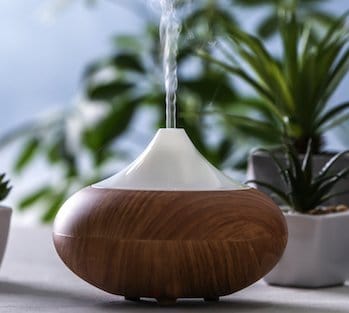 ay suspended in the air for a good length of time. It is a fairly economical way to diffuse and it is easy to combine essential oils. Only a few drops of each oil is necessary.
ay suspended in the air for a good length of time. It is a fairly economical way to diffuse and it is easy to combine essential oils. Only a few drops of each oil is necessary.
The diffuser can also act as a humidifier. This type of diffuser usually has a timer so it can be set to run for a particular length of time. Generally, there is a safety on/off switch when the water level runs low and they are easy to clean and easy to use. Some have color changing lights.
This is a good choice to use with children and pets because oil concentrations will not be too strong.
Disadvantages: This style of diffuser is not advisable in high humidity environments or when mold is a problem. Because it emits the oils in a micro-fine mist it will add humidity to a room. It is not recommended to use citrus or cinnamon oils in this type of diffuser because they can damage the flexible membrane inside the unit.
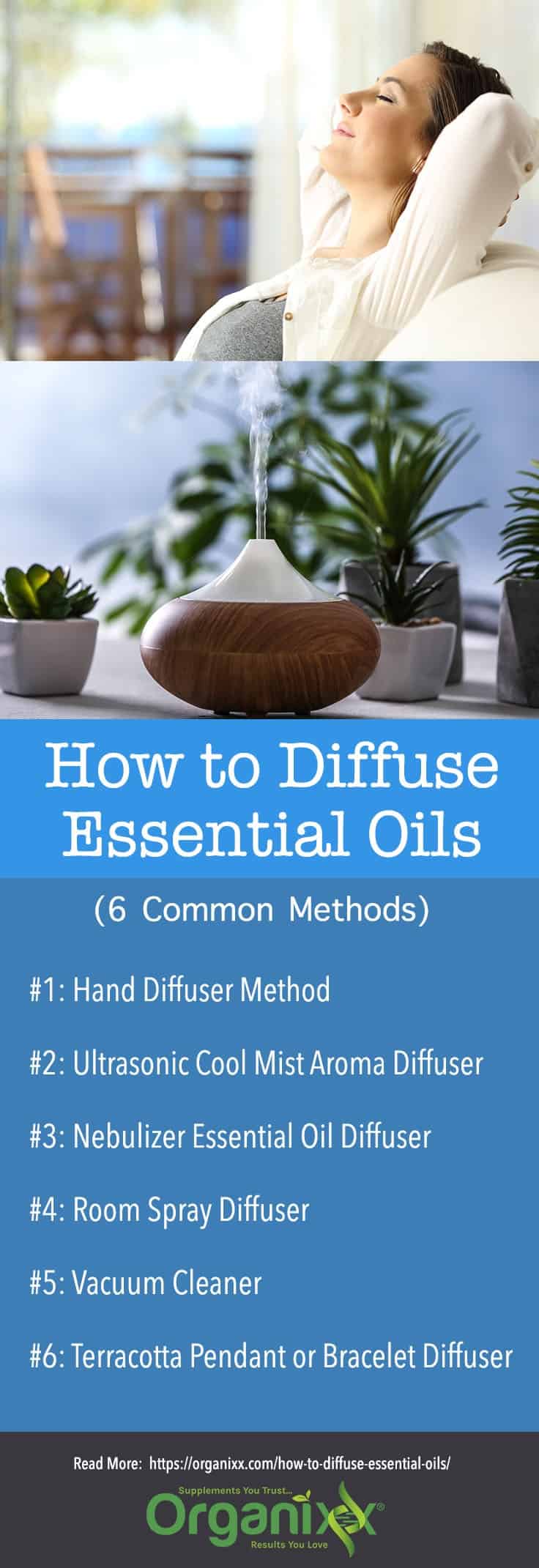
Nebulizer Essential Oil Diffuser
Also known as a cold air diffuser, it is an electrical device consisting of an air pump that pumps a stream of air across a nozzle tube, creating a vacuum and causing essential oils placed into a small reservoir to move upward. As they rise, the stream of pressurized air hits the droplets of essential oil. This atomizes them into micro-particles, which fill a glass tube, where they rise and are emitted as an ultra-fine vapor.
Advantages: Because the essential oils are not diluted or heated in any way this best retains their therapeutic properties. Because the molecules of oil released are ultra-fine, they tend to stay suspended in the air for a number of hours. This method helps to increase the oxygen content in the oil molecules. No humidity is added to the room as with the ultrasonic cool mist diffuser. The unit is reasonably easy to use.
Disadvantages: Nebulizer diffusers can be more costly to purchase than other types of diffusers. They can also be more expensive to run because essential oils are not diluted and this type of diffuser can use up a bottle of oil more quickly. It is reasonable to expect to go through 15-20 drops of oil in an hour-long diffusion session. It can be more difficult to use a blend of essential oils since a single bottle is normally placed on the atomizer, although this can be overcome by choosing an essential oil blend.
The glass tube of the nebulizer must be kept clean by running alcohol through it between uses. It must also be handled carefully as it can easily break.
More viscous essential oils such as patchouli, sandalwood, and vetiver may not be suitable as they can clog the device.
Lastly, because the essential oils are not diluted and stay suspended in the air for quite some time, it is best to keep children and pets out of the area where this diffuser is running – except for very brief spans of time and under the direction of a qualified practitioner. The final drawback is this type of diffuser can be noisier than the ultrasonic cool mist type.
Room Spray Diffuser
This essential oil diffusion method involves filling a glass spray bottle with distilled water, then adding the desired essential oils. For a 1% dilution, use 5-6 drops of oil for every one ounce (30 ml) of distilled water. For a 2% dilution, use 10-12 drops for every once of water (and so on). Shake the spray bottle vigorously prior to spraying into the room.
Advantages: This method is quick and easy. It immediately kills any odors present and is cooling in the summertime. It requires no heat, no electricity, no batteries, and can be taken anywhere.
Disadvantages: This method adds humidity to the room. The essential oils are not suspended in the air for very long. You must use a glass spray bottle if you intend to store the mixture for any length of time because essential oils eat through most plastic. Therapeutic value is nominal, but it is a quick method for freshening the air in a non-toxic manner.
Use Your Vacuum Cleaner as a Quick Diffuser
In this method, you apply a few drops of essential oil to a cotton ball, then just vacuum up the cotton ball. As you are running the vacuum, it is dispersing essential oil vapor into the room.
Advantages: Quick and easy; it requires no extra equipment other than a vacuum cleaner.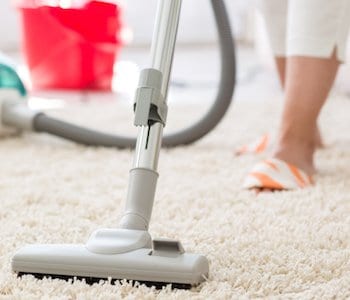
Disadvantages: The vacuum cleaner must be running for the oils to be dispersed. This method is really only good to change the scent of the air of the room in which you are working.
Terracotta Pendant or Bracelet Diffuser
This method features a terracotta (clay) disk hanging from a necklace, or clay beads (sometimes lava stone) set in a bracelet. Simply apply the oils to the clay disk or beads and inhale the vapor as it evaporates.
Advantages: Inexpensive, wonderfully portable, guaranteed to make someone say “You smell amazing!”, and a good way to help protect against airborne bacteria (such as on a long airplane journey).
Disadvantages: The aroma of the essential oils is depleted pretty quickly so needs to be reapplied fairly frequently.
Diffusing Methods NOT Recommended
Reed Diffuser
This method involves the use of a small vase or bottle partly filled with aromatic oils and several thin rattan or wooden reeds. The oil and fragrance wick up the reeds, releasing fragrance into the room where the reed diffuser sits.
Advantages: Reed diffusers are visually appealing. High-quality essential oils can be utilized, and they are inexpensive to make, depending upon the essential oils utilized.
Disadvantages: Unless you make your own, reed diffusers normally are sold as a kit with synthetic fragrances that are often bad for your health. These synthetic fragrances are usually made with hormone-disrupting chemicals, adulterated oils, and other toxic chemicals.
Even if you use reeds with your own with organic essential oils, this method tends to be more expensive because large quantities of essential oil are required. Lastly, unlike ultrasonic diffusers or nebulizers, the molecules of essential oil are not diffused and suspended into the air, but only in a small zone around the reeds.
Ceramic Oil Burner
Ceramic oil burners contain a reservoir into which essential oils are placed, with or without water, and then placed over a heat source, like a tea light candle or are warmed with electricity. The heat vaporizes the molecules of essential oil and releases them into the air.
Advantages: Ceramic oil burners are generally inexpensive, visually appealing, and only a few drops of essential oil are required.
Disadvantages: The risk of not remembering they are burning and causing a fire is high. The most compelling argument against essential oil burners, however, and the main reason this method is not recommended when using essential oils for health reasons is that it is not good to heat essential oils.
Essential oils are volatile, delicate, and contain the life energy of the plant from which they are derived. When heated, the phytochemicals (plant chemicals) are compromised and the therapeutic content of that oil is destroyed.
For recreational fragrancing, the ceramic oil burner is adequate. But if you really desire to support your health with essential oils, choose other recommended diffusing methods above.
Helpful Tips for Diffusing Essential Oils
If using the ultrasonic or nebulizer style diffusers, it is a good idea to start slowly when first diffusing essential oils. This allows your body to become more accustomed to the oils.
Start with a diffusion time of 15 minutes and slowly increase the time over a period of days. If you start to feel woozy or not well while diffusing, it may be a detoxification reaction. Turn off the diffuser and drink filtered water; then reduce diffusing times until your body adjusts.
Be careful not to blend too many essential oils together at one time, as this can be overwhelming to your senses if you are just beginning to use them. New to essential oils? Try diffusing just one to three oils at a time.
A Note About Diffusing Essential Oils Around Pets and Children
Many holistic veterinarians diffuse essential oils in their clinics to help calm animals, reduce aerial bacteria and fungi, and eliminate less-than-wonderful smells. It can also be safe to diffuse high-quality essential oils around pets at home if you do your homework first and follow good safety practices. For example:
- Err on the side of caution and only use tiny quantities of oils around your pet. Animal’s bodies are much smaller than ours and they do not need or tolerate the same amount of essential oil that their humans do.
- If your pet does not like the aroma or begins to act strangely when diffusing: stop. Take them out of the room. Never leave an animal in a closed room with a diffuser going.
- Ensure you only use quality, non-toxic essential oils that are considered safe for your particular type of pet. It’s important to note that dogs, cats, and birds all react differently to different types of oils – so it’s best to get some guidance before proceeding.
 For children, much the same holds true. If you follow a few simple guidelines, diffusing essential oils is one of the best ways to use them with children.
For children, much the same holds true. If you follow a few simple guidelines, diffusing essential oils is one of the best ways to use them with children.
- When choosing which oils to diffuse for children, get the advice of a qualified aromatherapist because not all essential oils are safe to use with children.
- For babies under three months, essential oils should NOT be diffused or applied topically unless there is a compelling reason for doing so. Babies of this age generally do not need essential oil intervention but on the odd occasion that they do, only work with a highly skilled aromatherapist/health practitioner.
- When diffusing, the ultrasonic cool mist diffuser is a wise choice for older children because the oils are diluted and emit a less concentrated mist into the air.
Essential Oil Purity Is Paramount
When choosing a brand of essential oils for health reasons, purity matters greatly. It is wise to choose a company that only offers organic, non-GMO essential oils. Make sure that the company knows how to properly distill the oils so that the content of natural chemical compounds of the oils has not been compromised.
Beware of cheaper essential oils because these oils are usually created with or diluted by potentially toxic chemicals. When you consider purchasing from an essential oil maker, ask questions about how they distill the oils, where they source their oils, and how the plants were grown. Check out this article for tips on how to test your oils for purity.
The powerhouse trio of herbs in Magi-Complexx Essential Oil provides the strongest, most synergistic healing effect, helping sufferers of arthritis pain, constant muscle aches and pains, neuropathy, systemic inflammation, slowed wound healing, circulatory challenges, as well as skin irritations like eczema, psoriasis, and acne.
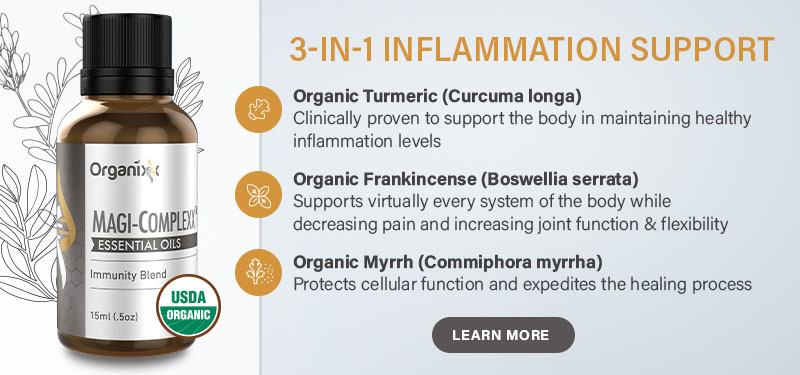
Article Summary
Diffusing essential oils can be one of the best ways to enjoy their therapeutic effects.
14 compelling reasons for diffusing essential oils. Diffusing can help to:
- Boost brain function by increasing mental clarity, memory, and motivation
- Ease depression, anxiety, and negativity
- Rid the home or office of airborne bacteria, fungi, and mold
- Control indoor allergens like dust mites and animal dander
- Alleviate sinusitis, head colds, bronchitis, flu, and other sinus-lung related complaints
- Cleanse a room of unwanted odors
- Boost the immune system
- Calm the mind prior to/during meditation practice
- Ease stress in the home and working environment
- Ready the mind and body for sleep, and improve sleep quality & depth
- Set a mood prior to the arrival of guests in the home
- Calm the children
- Help with weight loss by reducing food cravings
- Be used just because they smell amazing!
Common ways to diffuse essential oils:
- Hand Diffuser Method
- Ultrasonic Cool Mist Aroma Diffuser
- Nebulizer Essential Oil Diffuser
- Room Spray Diffuser
- Vacuum Cleaner (as a quick diffuser)
- Terracotta Pendant or Bracelet Diffuser
- Reed diffuser
- Ceramic oil burner
Many holistic veterinarians diffuse essential oils in their clinics to help calm animals, reduce aerial bacteria and fungi, and less-than-wonderful smells.
When choosing which oils to diffuse for children, get the advice of a qualified aromatherapist.


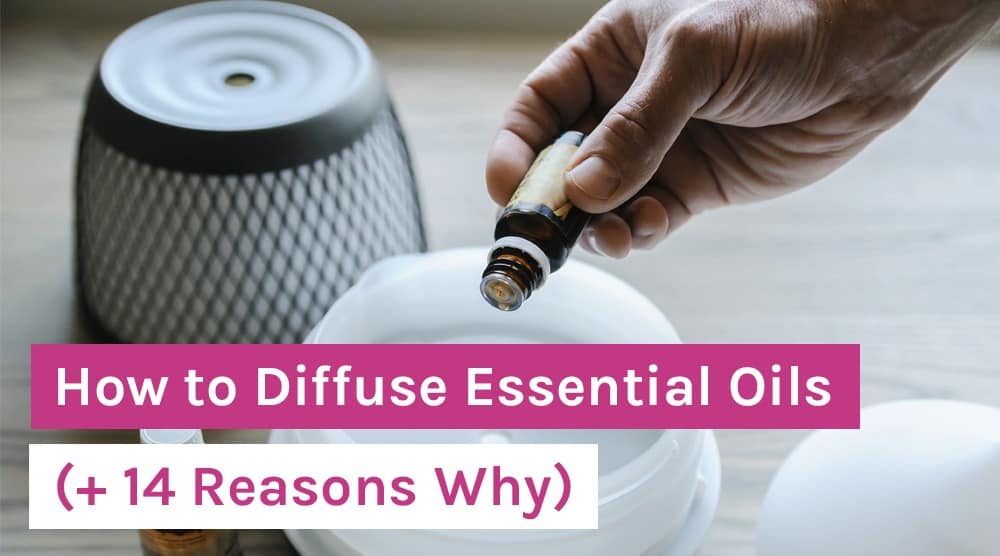
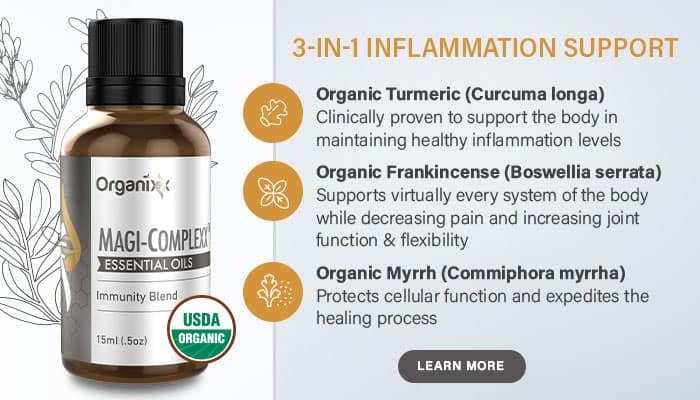


Great to read about the use of essential oils with diffuser thanks again for such useful information you people do a great job as usual thanks again
Regards Chris Simmons
ps you must have read my mind as we have just been talking about diffusers thanks again
Hi Chris! Thank you for taking the time to read our article and leaving a feedback. We are glad you enjoyed reading this one!
Great information, however, where to buy the diffuser?
Thank you for the positive feedback on this article, Judy.
We do not have a certain place/store to recommend, but you may check out your nearest department store or online shopping sites to check out the best diffuser that will fit your needs and budget. We hope you find the perfect one for you!
So where is the place you recommend?